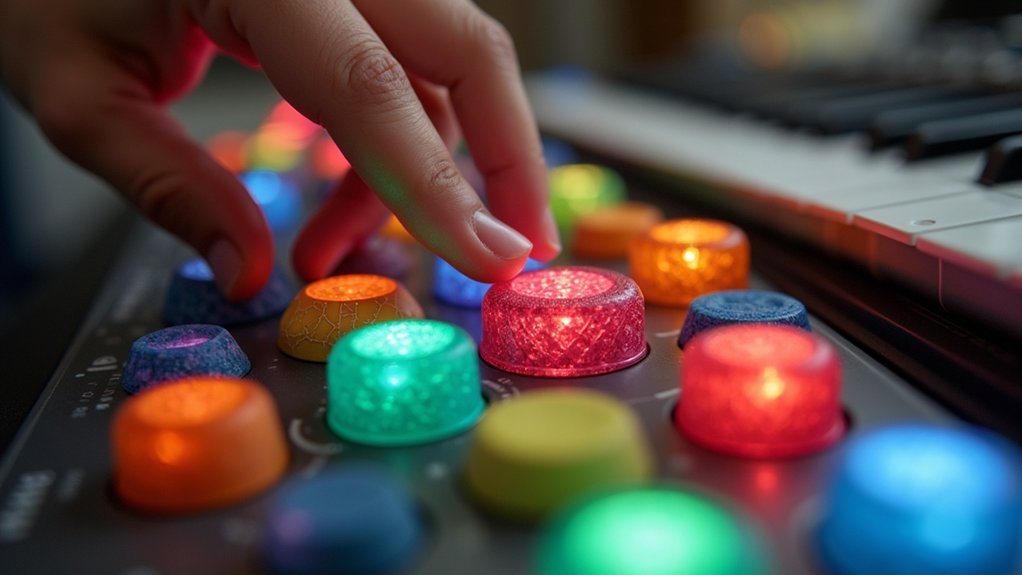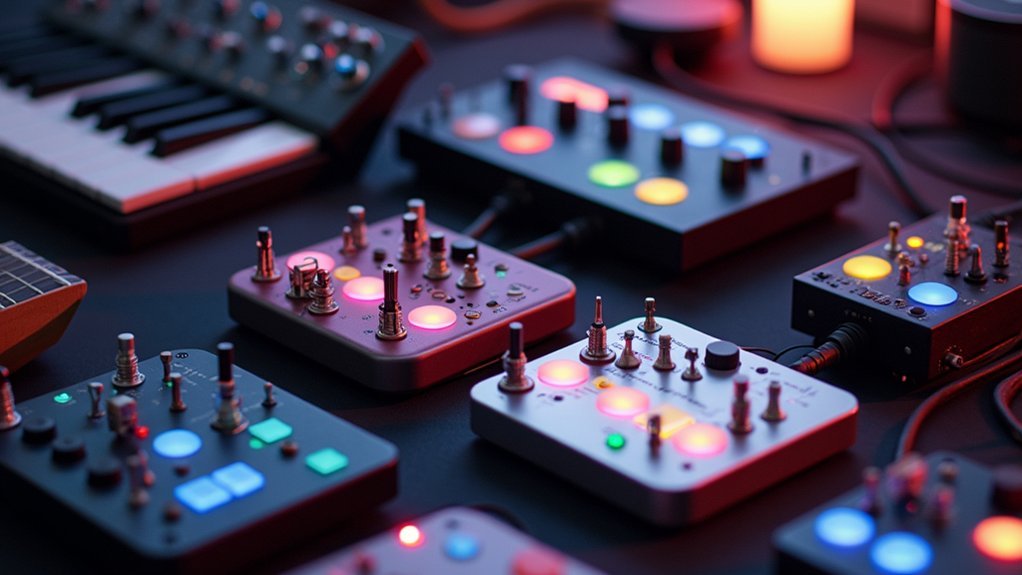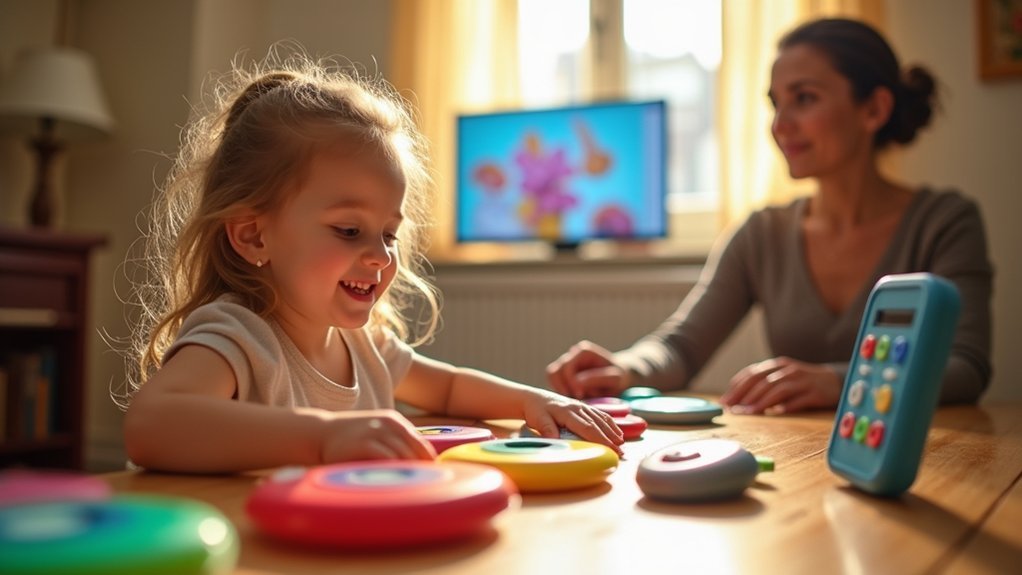When choosing switch music devices for disabled individuals, start by evaluating their specific motor capabilities, whether they can press, tap, or blow. Select adaptive switches that match these abilities, such as Sip-and-Puff for mouth control or Bright Switches for visual accessibility. Verify compatibility with intended software and consider budget constraints, from basic $50 options to advanced $300+ systems. The right device not only provides musical expression but delivers therapeutic benefits like improved social skills and emotional development.
Understanding Different Types of Adaptive Switches for Musical Expression

When exploring music-making options for individuals with disabilities, you’ll find that adaptive switches serve as essential gateways to creative expression.
The 36-inch Easy Flex Sip and Puff Switch allows users with limited motor control to create music through mouth operation, while anti-contamination filters and extra straws enhance its functionality.
For versatility, consider the 4-in-1 Joystick Switch, which accommodates multiple connections to suit diverse user needs.
If comfort is a priority, Adjustable Angle Switches can be customized between 32 to 90 degrees, adapting to unique physical challenges.
Don’t overlook visual accessibility—Bright Red Switches and the Bright Switch for the Visually Impaired make locating and activating musical devices easier, empowering users to engage confidently with their instruments.
Assessing Individual Motor Capabilities and Physical Accessibility Needs
Before selecting a switch music device, you’ll need to conduct a thorough assessment of the individual’s motor capabilities to guarantee an appropriate match. Observe how they control movements like pressing, tapping, or blowing, which reveals which adaptive switches will work best.
Consider the physical environment where the device will be used. Can the user easily reach and operate the switch while seated or standing? Don’t forget to involve the user in the selection process—their preferences greatly impact engagement in music-making activities.
| Assessment Area | What to Look For |
|---|---|
| Motor Control | Pressing, tapping, blowing abilities |
| Environment | Reach distances, mounting options |
| User Preferences | Comfort level with different adaptive switches |
Compatibility With Musical Software and Instruments

After identifying the right switch based on physical capabilities, you’ll need to confirm the device works seamlessly with your intended musical tools.
Check that your switch music device integrates with digital audio workstations (DAWs) you plan to use for music creation.
Compatibility between your switch device and preferred DAWs ensures seamless creation without technical barriers.
For devices like MySwitchMusic, you’ll need to configure MIDI settings properly when connecting to software such as KONTAKT PLAYER or LoopBe1. This often requires setting up virtual connection cables for best functionality.
If considering gaze-controlled options like the EyeHarp, verify compatibility with music software supporting MIDI inputs.
Some switches, including the Playtronica TouchMe, can transform everyday objects into controllers compatible with smartphones or computers.
Always confirm your selected device works with both adaptive instruments and traditional music software to maximize accessibility and enhance musical expression.
Budget Considerations and Purchase Options for Switch-Activated Devices
Steering through the cost landscape of switch-activated music devices requires careful planning since prices vary greatly based on complexity and features. When budgeting for adaptive switches, consider both basic and advanced options to match your needs.
| Device Type | Price Range |
|---|---|
| Basic Switches (Pal Pad) | $48.95 – $65.00 |
| Mid-Range (Buddy Button) | $65.00 – $95.00 |
| Advanced Controls (PowerLink®4) | Up to $330.00 |
| Classroom Switch Kits | $914.95+ |
Don’t forget to account for accessories like battery adapters ($20.00) and anti-contamination filters that enhance usability. Use “Add to Cart” and wishlist features on purchasing platforms to track potential buys and manage your budget effectively. Look for bulk purchase discounts when outfitting classrooms or therapy spaces.
Therapeutic Benefits and Engagement Metrics When Selecting Music Devices

When evaluating switch-activated music devices, their therapeutic value becomes an essential consideration beyond mere accessibility features.
Look for options that enhance social skills and emotional expression, as making music can provide significant cognitive benefits for users with physical challenges.
Devices like the Skoog or software with external switches allow both visually impaired individuals and those with limited mobility to play a musical instrument independently.
Track engagement metrics such as sustained attention and creative expression when reviewing different options.
The right device should encourage fine motor skill development through interactive play while fostering a sense of accomplishment.
Remember that music plays a fundamental therapeutic role beyond entertainment.
Choose devices that support improvisation and self-expression to maximize motivation and satisfaction in therapeutic contexts.
Frequently Asked Questions
What Disability Are Switches For?
Switches are for you if you have motor limitations, physical impairments, or cognitive disabilities. They’ll help you operate computers, wheelchairs, and other devices independently when you can’t use conventional controls.
What Is Adaptive Equipment for Disabilities?
Adaptive equipment for disabilities includes specialized devices you’ll use to overcome physical, sensory, or cognitive barriers. They’re designed to help you perform daily tasks and participate in activities with greater independence and accessibility.
What Is a Switch Communication Device?
A switch communication device is a tool you’ll use to control electronic equipment with simple button presses. It connects with 3.5mm plugs, allows customizable programming, and helps you express yourself independently despite mobility or communication challenges.
What Is a Capability Switch?
A capability switch is an adaptive tool you’ll use to control electronic devices with simple actions like pressing or puffing. It’s customized to your needs, allowing you to operate music-making equipment despite physical limitations.
In Summary
Choosing the right switch music devices for someone with disabilities requires careful consideration of their unique needs and abilities. You’ll find success by matching adaptive switches to their motor capabilities, ensuring software compatibility, and staying within budget. Remember, the perfect device will enhance both therapeutic outcomes and musical enjoyment, creating meaningful opportunities for creative expression and independence through music.





Leave a Reply